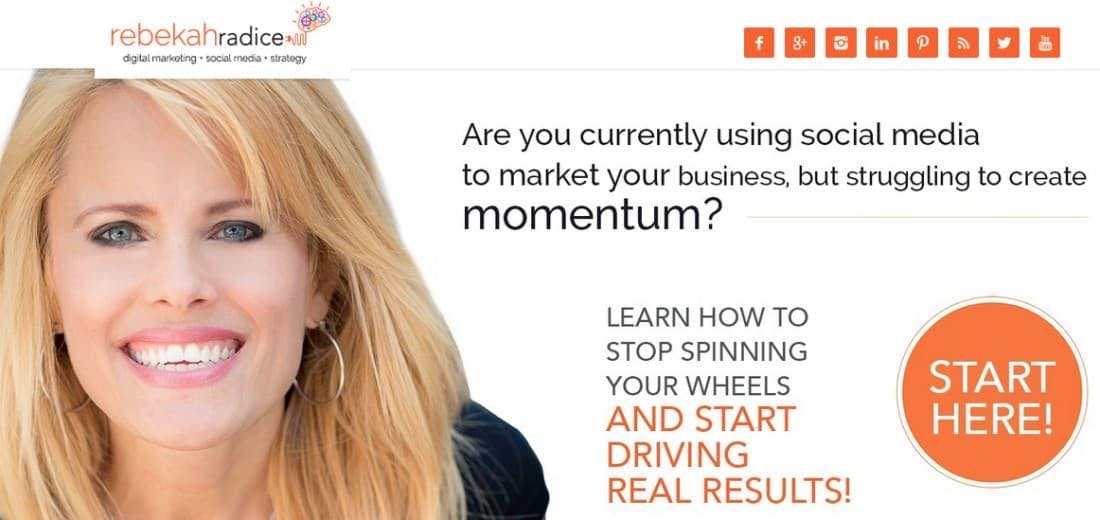Whether you’re a local business owner, entrepreneur, or brand - finding new ways to generate business can be a challenge. Especially in the highly competitive online world where content is King and differentiation is the fine line between success and failure. That’s where blogging comes in.
Building a successful business blog can give your business the edge it needs. Not only is it a cost-effective way to enhance your inbound marketing efforts, but it also becomes a magnet—attracting prospective clients in an organic and natural way.
Whether you're looking to start a blog from scratch or reinvent your current blog, this post will walk you through the setup of a successful (and profitable) business blog.
How do I know these steps will set you up for success? Because they're the exact steps I took to set up my award-winning blog! Ready to get started?
Read my ultimate getting started guide to building your business blog. And don't forget to leave a comment with a link to your blog. I'd love to hear (and see) how blogging is supporting your business!
Is a business blog really important?
A business blog is an essential element of your marketing strategy. And I tell you that from years of experience. I started my first blog (the very one you’re on right now) in 2004.
At the time, I was in the real estate and mortgage industry and looking to make connections on a local level. But I quickly figured out the national implications as well. I began building relationships within my industry, creating connections I would have never been able to make otherwise.
Many of those relationships blossomed into true friendships that I still hold dear today. Many others turned into business opportunities. Whether it's speaking at a national event or traveling as a brand ambassador, blogging has opened (and continues to open) doors for me I never thought possible.
One of my most recent achievements is being named a 2015 Top 10 Social Media Bloggers by Social Media Examiner. This was a monumental moment in my blogging career and an honor that made every long, sleepless and stressful night worthwhile.

So think about it. What are you losing by not having a blog? And what could you accomplish tomorrow if you started a blog today?
Benefits of a business blog:
Beyond the benefits I've mentioned above, what else can a blog do for your business and personal brand?
- Improves rankings by boosting SEO
- Establishes you/your business as an industry leader
- Builds credibility through the know, like and trust factor
- Decreases marketing costs through an integrated strategy
- Allows potential customers to self-select and move through your sales funnel
- Generates the right kind of leads, bringing your perfect customer to your doorstep
How to build a successful business blog
Now that you know the significance of a business blog, you need to learn how to build one successfully and at little or no cost. Whether you're starting from scratch or reviving an old blog, don't feel overwhelmed.
I'm going to break down the exact steps you need to take to build a successful and profitable blog.
1. Identify your topic
Your topic is the foundation of your blog. It drives your keyword research, content, message, voice, tone and structure. But before you decide, let me offer a word of caution.
Make sure your topic is something you’re passionate about. Because without passion, your blogging efforts will quickly fizzle.
Struggling to find the purpose behind your blog? Answer a few important questions:
- What drives and excites you?
- Where do you see yourself in 5 years?
- Is your brand unique?
- Is your message clear and powerful?
- Do you have a system in place to effectively stay in front of prospects and past clients?
- Is there an audience for your topic?
- Is it a sustainable topic?
A couple of these are soul-searching, gut wrenching “why the heck do I get out of bed” questions. Take your time to answer them. Ignoring your answers is a mistake and a regret you will have down the road.
2. Know your target market
To attract readers and eventual subscribers to your blog, you have to speak their language. If your blog is centered around your business, this also means they'll eventually be customers or clients.
Your first stop is research. You want to know what your market is looking for and then determine how to best position your content. I suggest getting crystal clear on who you're going to be talking with.
Who is that reader—what do they look like, what do they do and why are they looking for your blog? With this information, you'll build out a customer or reader persona. If you haven't done this for your business, it's a great exercise to identify target market.
Start by identifying how you'll win by knowing your: who, issues, and needs
- Who: Who will you be talking with on your blog? List your target market. Mine, for example, is small business owners, entrepreneurs, and marketers.
- Issues: What issues is your target market dealing with? Mine would be finding enough time to manage social media, juggling a business online and offline, budget, conversion, and results.
- Needs: What are the needs of your target market? This is where you’ll start to identify opportunity. What problems can you solve and what solutions will you provide?
Once you know your target market, writing content specifically tailored to their needs becomes terribly easy. Like this one written for Post Planner. My target market is their target market—savvy business professionals using social media to market their business.
It's no secret that I believe Pinterest is an amazing tool. My goal in this article was to assist marketers still struggling to understand the channel to really wrap their head around it.

3. Choose your domain, hosting, and theme wisely
Everything from your website theme, design, content and structure tells your businesses story. What story is yours telling?
If it screams old, outdated and obsolete, it’s time to clean house and make a change. And when you do, make sure it’s responsive. According to MarginMedia,
“48% of users say that if they arrive on a business site that isn’t working well on mobile, they take it as an indication of the business simply not caring.”
Steps to getting started:
- Finding the right domain name is a crucial piece to building a successful blog. Do your research, understand the keywords people are using to find your product or service and then keep your blog and domain name consistent.
- Purchase your domain and setup hosting. You don’t have to do this through the same company, but it does make setup easier.
- Hosting is a big decision and not to be taken lightly. You have free blog hosting and paid. In my opinion, if you’re building a business blog, Wordpress (org not com) is the only way to go.
- Not sure what the difference is? Here’s a nice visual breakdown from Ramsay at BlogTyrant:
- I won’t go into the details of setting up hosting in this post, but will direct you to an excellent article on Wordpress hosting options.
- Once you’re ready to add Wordpress to your hosting, follow their detailed instructions.
4. Establish your goals
Like anything worthwhile, blogging will take an investment of time and energy. Before you create your business blog ask yourself why you want to start a blog, what you want to get out of it and what you want your audience to get out of it.
Do you know what you’re looking to achieve with your blog? If you don’t - you're headed for failure. As with anything, if you don't know what you want to get out of it, you shouldn’t get into it.
Now determine how often you can blog and stick with it. Knowing this will allow you to stay consistent. Because consistency can be a deal killer.
Think about it. When was the last time you revisited a blog that wasn’t recently updated? Probably never. Don’t shoot yourself in the foot by making this big mistake.
5. Build rapport through relevant content
Once you’ve set up your blog, it’s time to start writing. Blogging about niche-specific topics is an excellent way to build rapport. Researching new trends and updates within your industry as well as community needs and market indicators will keep your name top of mind and regarded as cutting edge.
Create a blogging strategy based on current content that can be repurposed and distributed through your social channels. For example, a blogging strategy to increase brand visibility might include:
- A product (i.e., e-book) that you blog about and offer as a free download
- Holding a contest, blogging about it and encouraging existing subscribers to help spread the word
- Asking friends, family, past clients and colleagues to subscribe and provide constructive feedback
The goal is to grow an audience while retaining current subscribers as faithful followers and active participants. When readers find your content to be professionally written and highly informative, they are more receptive and trusting.
A blogging strategy to help build rapport while elevating your brand might include:
- 2 blog posts per week about the latest industry information (focus on solving a problem or challenge)
- A series of “how-to” posts that provide strategic ways to grow their business career field
- A tutorial on how to create an effective social media strategy to increase sales conversions
6. Create a regular schedule
The key to every successful blog is consistency. Determine how often you’ll post and what days of the week you’ll publish new articles. Creating consistency in your posting schedule does two things.
It forces you to build a habit around writing - something many struggle with, especially at first - and it sets expectations for your readers. An editorial calendar will also keep you focused on your topic and posting regularly.
Here's an example of an editorial calendar:

From the very beginning, I chose Monday as my publish date. I knew, based on my schedule, that I could only commit to one post per week. Monday was my day, mainly because it gave me the weekend to put my post together.
While there are many opinions on what day of the week is best, Monday has worked well for me. There are ways to look into your Google Analytics to find the best times to post, but this data won’t be available if your blog is new.
To get started, answer a few questions:
- How much time can you devote to writing new posts each week?
- How many posts can you realistically write (and post) each week?
- Will you be the only one contributing to the blog or will others be writing content?
- Where will you capture content ideas - stories, tips, answers to reader questions? I find it easiest to use Google Drive. This makes my list accessible, no matter the device.
- What day of the week will you post your first article? (once the first one is live, get that day and time into your calendar. Begin to track your results in Google Analytics)
- Create an editorial calendar to maintain focus and keep your blogging efforts on track. Here’s a sample and breakdown of how to best create your own.
Remember: building trust doesn’t happen overnight. To become a trusted resource, you must establish credibility by consistently offering valuable content.
Because as social media strategist Kim Garst says,
“If people like you, they’ll listen to you. But if they trust you, they’ll do business with you.”
7. Brand your business
Have you created a consistent look, feel, message, tone and voice across your blog?
If not, take a moment to ensure:
- You are reinforcing your business or brand mission, vision and values in every way possible
- Every page, post, and image on your website has a clear call to action
- You’ve eliminated distractions and allowed a crisp and clean user experience
- Your languaging is natural and aligns with your overall style
- The design of your website including color, scheme and fonts are consistent across all of your social networks
- Your images are professional and used legally within copyright laws
It's no secret, my color is orange. It's everywhere you look and on every page of my blog. Don't miss the opportunity to make a visual impact, but also one with your words and messaging. It all matters more than you know.

8. Build your list
Not building my email list. This was one of the biggest mistakes I made when initially launching my blog. I had a list I’d built within my business, but not one specifically centered around my blog. Don’t make that same mistake.
If you want to get the word out about your blog, building a subscriber and email list is a great way to do it. Write amazing content that goes out to just your email subscribers.
Get them excited and involved in your marketing efforts. Pat Flynn of Smart Passive Income shares this awesome tip which I totally subscribe to (pun intended),
I use my email list like I use social media – a medium to further connect with my readers, followers and subscribers. A place to interact (gasp!) and inform – not a place to promote and sell.
9. Promote, promote, promote
Writing your latest blog post and hitting publish is just the beginning when it comes to growing your subscription base. If you truly want to gain the attention of your target audience (and Google), then you will need to spend time promoting your content in multiple locations.
While there are many different ways to go about promoting your blog, I am going to focus on what I have found to be the most effective. Over the years I have compiled a detailed list of where, how and when to promote your latest blog post.
- Social Media
- Post to your Facebook profile and page
- Post a graphic specifically designed for Google+ and then pin that graphic to Pinterest (the size that works best for me is 735 x 1200)
- Create a unique graphic for Instagram and share with a short breakdown of key points
- LinkedIn - share to your profile and within a group. Writing about social media, marketing or small business? Become a member of the LinkedIn group I manage with over 35,000 members.
- Create a short “how-to” video highlighting some of the tips shared within your post. Add that to YouTube.
- Blogger Communities
- Video
- Guest Posts
- Commenting - Comment on blogs that fall within your niche. It’s an excellent way to create strategic relationships and connect with influencers within your niche.
- Newsletter
- Email Marketing
- Syndication
Peg Fitzpatrick, author of The Art of Social Media is an excellent example of cross-promotion at work. Every post she writes is promoted across each of her social networks.
How to Start Prioritizing Your Instagram Strategy From the outside looking in, Instagram appears to be selfies and...Posted by Peg Fitzpatrick on Monday, April 20, 2015
10. Track your progress
Install Google Analytics and track your progress. Pay attention to what content is working and what’s not. Not reviewing your statistics is like driving at night without your headlights on.
You may get to your destination, but the ride won’t be pretty. Not reviewing your blog stats is like driving at night without lights on. You may get to your destination, but the ride won’t be pretty.
— Rebekah Radice (@RebekahRadice) May 11, 2015
11. Start writing
Once your blog is set up, you've identified your topic, purpose, audience and keywords - it's time to start writing. A question I'm often asked is, "how long should my blog post be?" There's a lot of debate around this topic, but here's my short answer.
Write until you're done. That's it. Don't belabor the point or try to stuff content where it doesn't fit. When you're done sharing everything you feel is relevant, wrap it up.
And listen to this advice from Kathi Kruse, Social Media Marketer and Blogger at KruseControlInc. As a recovering perfectionist, I can tell you her advice is spot on.
“Don’t bother with perfection – it’s an illusion. Create something everyday, no matter whether it’s “good” or “not-so-good.” Write what you’re passionate about and edit it later.”
12. Never stop learning and teaching
Write daily and know that every word better connects you to your audience. Be a student of your craft and learn from others who are succeeding within your industry or field. Then take that knowledge and make it your own, unique to you.
Final thoughts
Turn your blog into the catalyst that drives your business forward. Identify your purpose and then write with conviction. Open up your creative floodgates and don't be afraid to give away your expertise. Sharing builds better connections and better connections builds trust, engagement and ultimately—your bottom line.
About Rebekah Radice
Rebekah Radice, co-founder of BRIL.LA, has traded narcissism for purpose. When not driving growth, you'll find her tricking family into thinking she's Emeril Lagasse - likely covered in marinara. The spotlight was fun, but impact is better. These days she's using 20+ years of brand brilliance for good.
